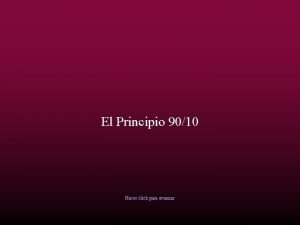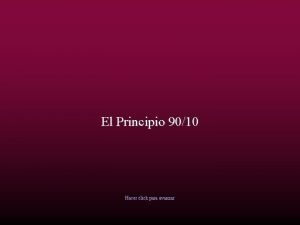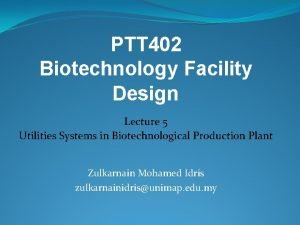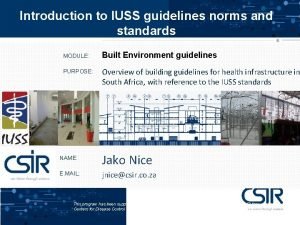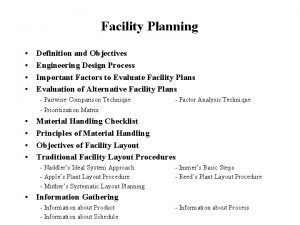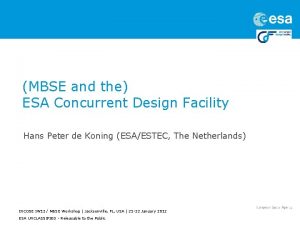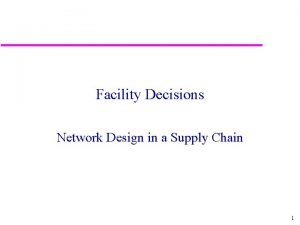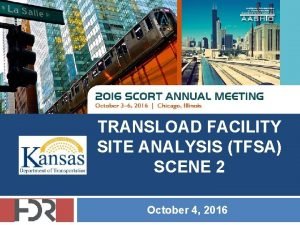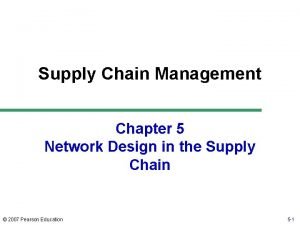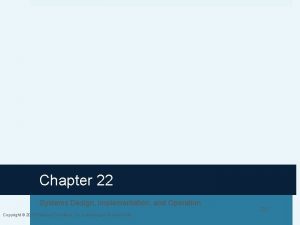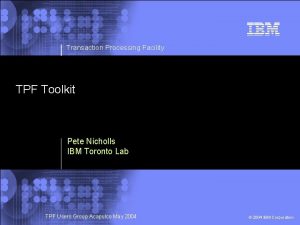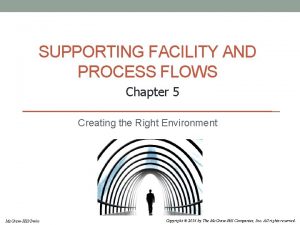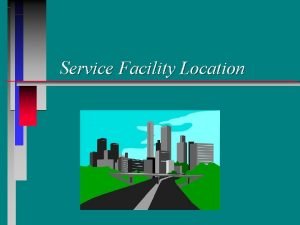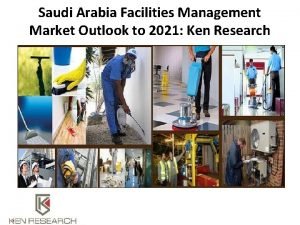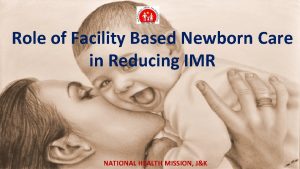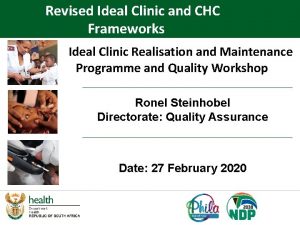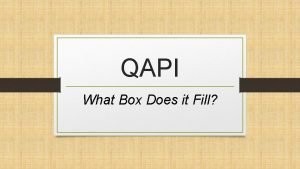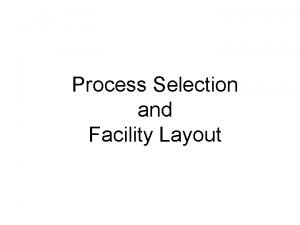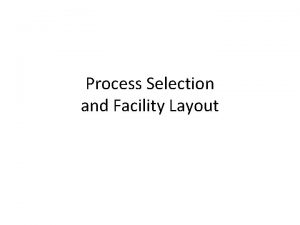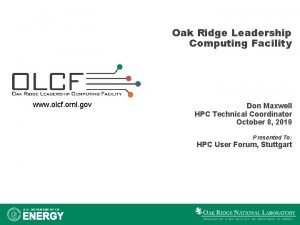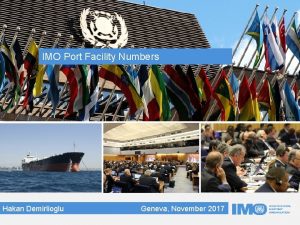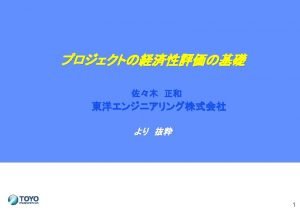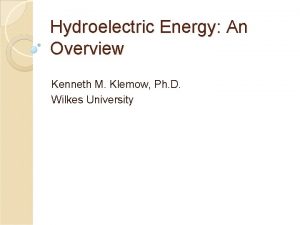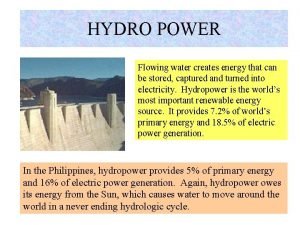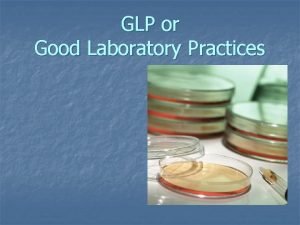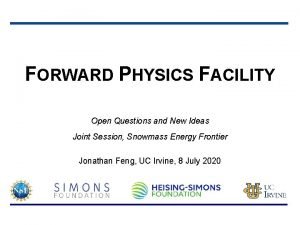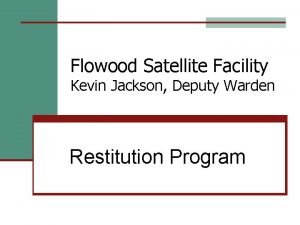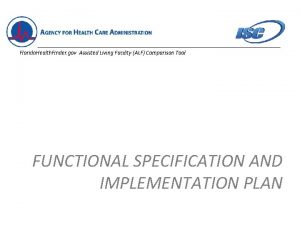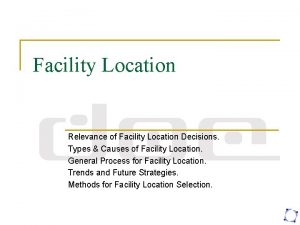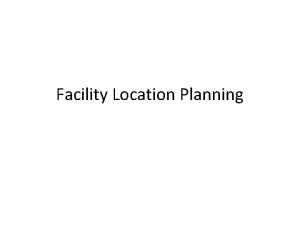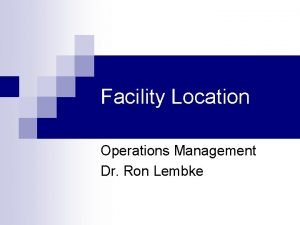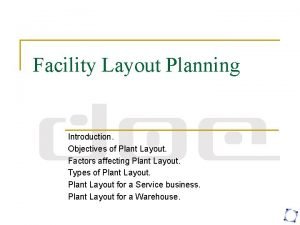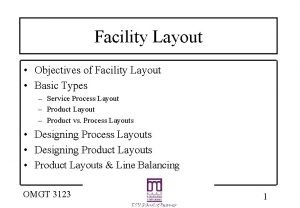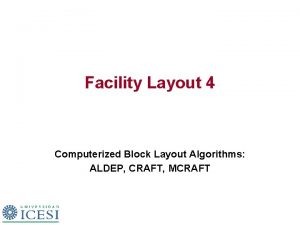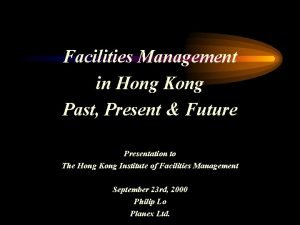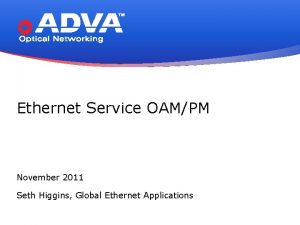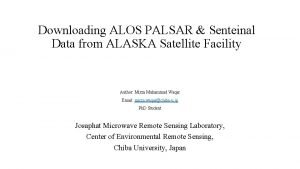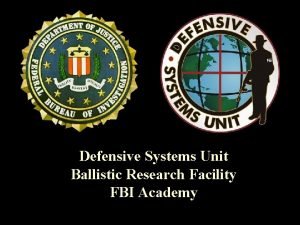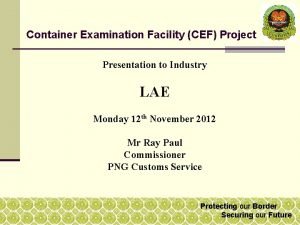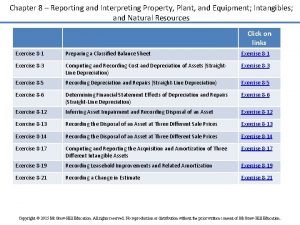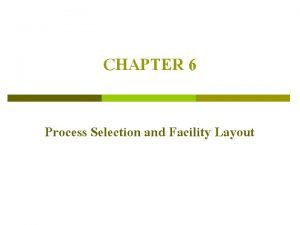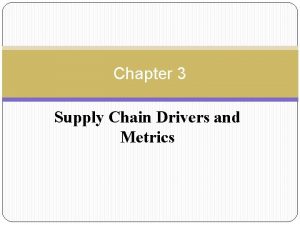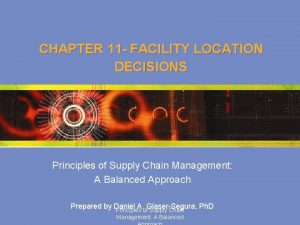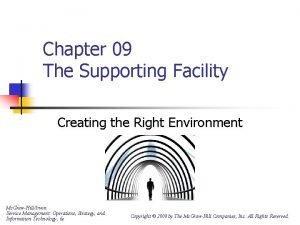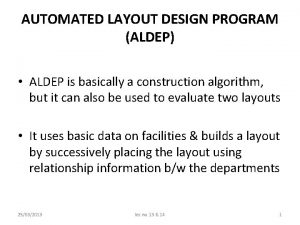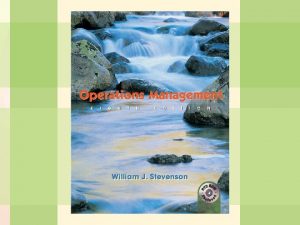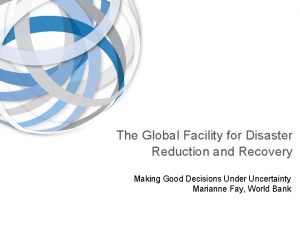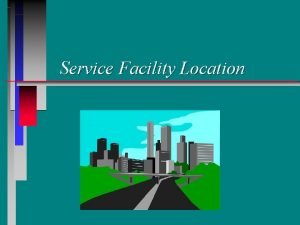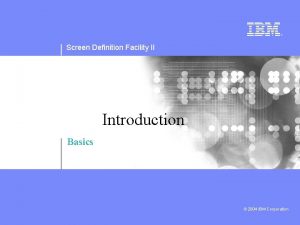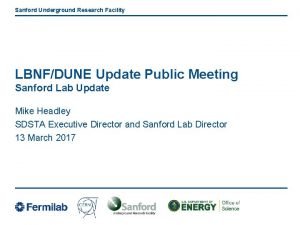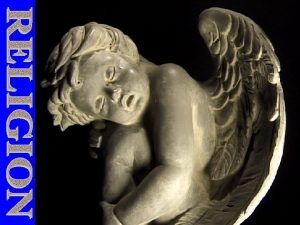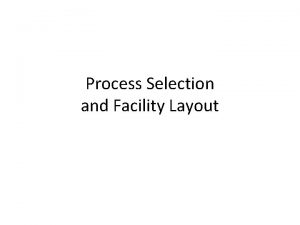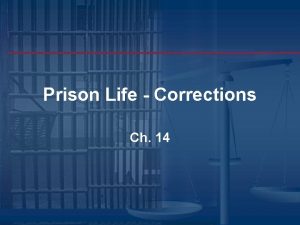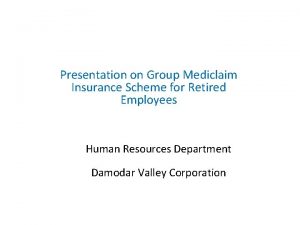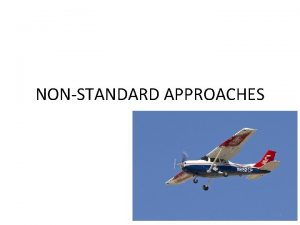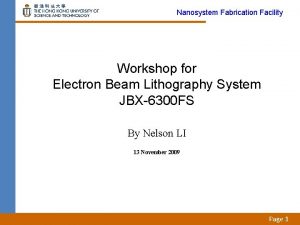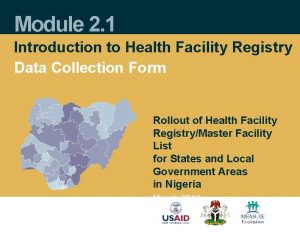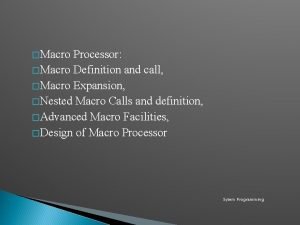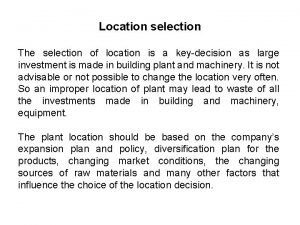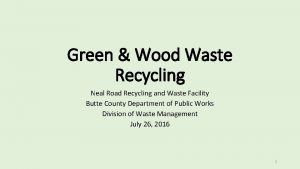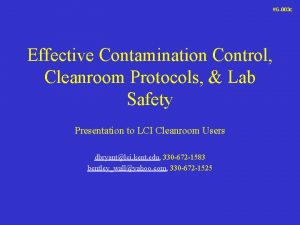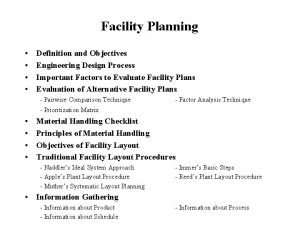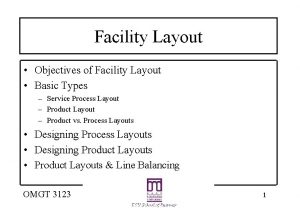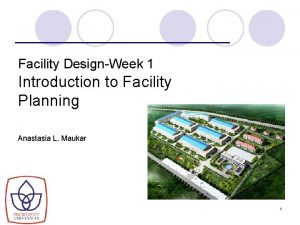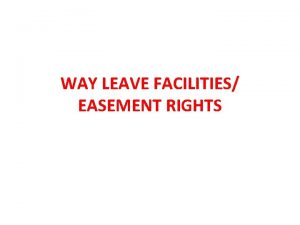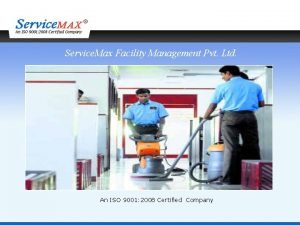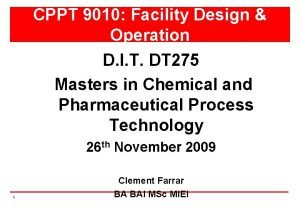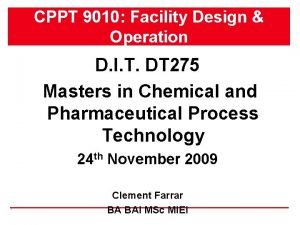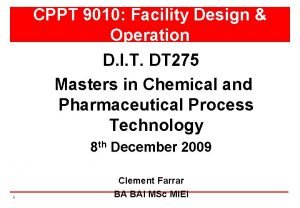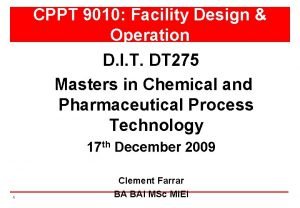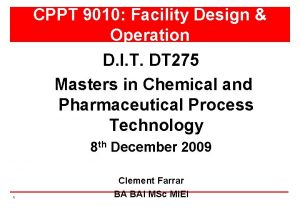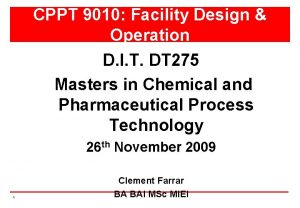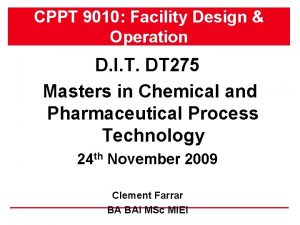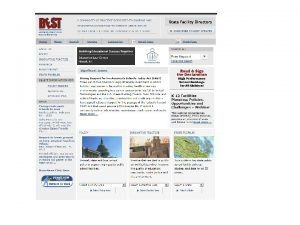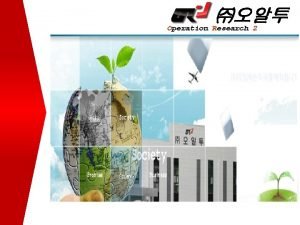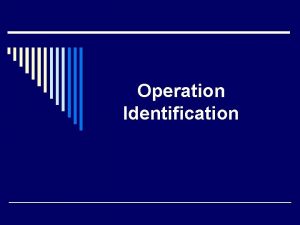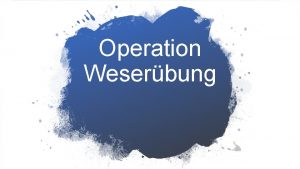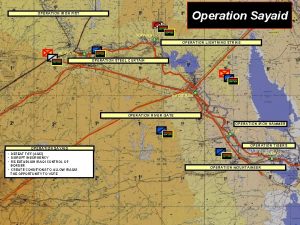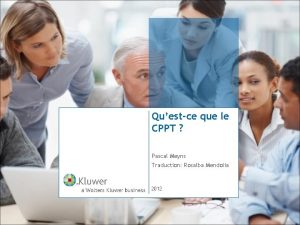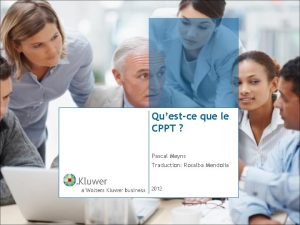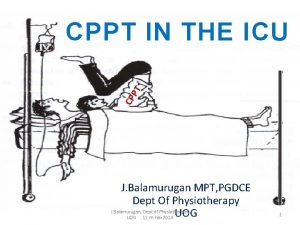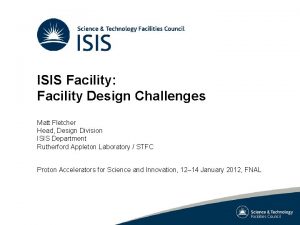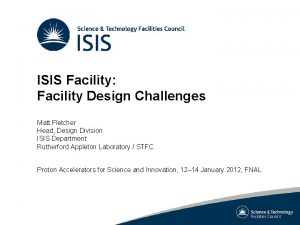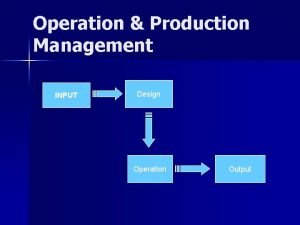CPPT 9010 Facility Design Operation D I T





































































































- Slides: 101

CPPT 9010: Facility Design & Operation D. I. T. DT 275 Masters in Chemical and Pharmaceutical Process Technology 17 th December 2009 1 Clement Farrar BA BAI MSc MIEI

Lecture Overview 1) General Support Utilities 2) Water 3) Clean Steam 4) Waste 5) CIP & SIP 6) Autoclaves 7) Washers 8) Solution Transfer 2

1) Support Utilities 3 n What are Support Utilities? n Why do we need Support Utilities?

Support Utilities 4 n Essential Utilities Ø Clean Steam Generators Ø WFI Generators Ø RO Skids Ø Potable Water Ø Process Air Ø CIP Skids n Other Utilities Ø Glycol Ø Instrument Air Ø CO 2 Ø O 2

Clean Steam (CS) 5 n Clean Steam is generated with Clean Steam Generators by the distillation of RO or WFI n Clean Steam is used for sanitization

Water For Injection (WFI) n Water for Injection (WFI) is a raw material (excipient) n Needs to be ‘clean’ - stripped of any inorganics, microorganisms and have low level of endotoxins n Suitable to inject intravenously n Uses include: Ø Final rinse for CIP’s Ø Clean Steam generation Ø Product formulations Ø Equipment washing 6

Gases n Oxygen O 2 Oxygen is an essential requirement for the growth of cells (in the case of bio-processing) Ø It is sparged through the bioreactor vessels via the oxygen/ carbon dioxide distribution loop Ø n Carbon Dioxide CO 2 Carbon Dioxide is used to maintain the desired level of oxygen Ø It is sparged through the reactor vessels via the oxygen/ carbon dioxide distribution Ø 7

Other Utilities n Glycol Ø Ø Ø n Instrument Air Ø 8 Glycol is used as the coolant (through vessel jackets) Glycol is stored in a Process Glycol Surge Tank Glycol is distributed throughout the process via the Glycol Distribution Lines Instrument air is high pressure air which is used to operate actuator valves and does not contact process contact surfaces

HVAC (Heating, Ventilation & Air Conditioning) n HVAC System Ø Ø HVAC systems are located in the interstitial places between the building floors Its purpose is to maintain the heat, ventilation and air conditioning at the desired level Air Handling System Supply Air 9 Production Room With Defined Requirements Outlet Air

Process Waste Treatment § 10 Process Waste must be treated prior to discharging from site

Cleaning & Steaming n Before process equipment can be used it must be Cleaned and Steamed (or Autoclaved) n Clean in Place (CIP) Ø n Steam in Place (SIP) Ø 11 Method of cleaning the process equipment and associated pipework using a variety of cleaning agents such as RO Water, Caustic, Acid and WFI Method of sanitizing the process equipment and associated pipe work by steaming at high temperatures (~121°C) until certain criteria are met and all micro-organisms are killed

2) Water 12

Water Overview § § § 13 Utility Water Clean Water Softened Water System RO (Reverse Osmosis) Water System WFI (Water for Injection)

Utilities Utility Water Plant Flow Chart Water User 1 Chlorine Analyser Utility Water Storage Tank Chlorine Analyser User 2 User 3 Distribution Pumps Sodium Hypochlorite Storage Tank & Dosing Pumps Inlet from Local County Council 14 Softened Water Plant User 4 User 5

Utility Water Usage § Uses of Utility Water Ø As utility water in all buildings (for cooling) Ø Domestic Water Supply to all buildings Ø Supply to the cooling towers Ø Chilled § Water Utility water feeds the softened water generation plant Ø For generation of RO & WFI Ø Boiler feed water 15

Why do we need ‘Clean Water’? § § 16 Water for Injection (WFI) is a raw material (excipient) Suitable to inject intravenously Needs to be ‘clean’ - stripped of any inorganics, microorganisms and have low endotoxin Specification of WFI defined in various Pharmacopeia’s

How do we make ‘Clean Water’? § § § 17 Drinking water is supplied to the facility Drinking water undergoes a series of purification steps to turn it into WFI Examples of Purification steps include softening, deionisation, distillation

Soft Water Generation n n Utility Water supplied to Soft Water plant Soft Water Generation Water is softened by removing hardness ions (Ca 2+ and Mg 2+) present in drinking water Ø Softener resins replace the hardness ions with sodium ions (Na+) Ø Soft Water plant also removes particulates from water using multi media filters Ø Soft Water is dosed with chlorine to control microbial growth Ø 18

Soft Water Plant Sample Schematic Multi Media #3 Multi Media #2 Multi Media #1 Utility Water Inlet 19 Bisulfite Addition User 1 User 2 User 3 User 4 User 5 To Site Distribution Water Softener #1 Water Softener #2 User 6 Soft Water Storage Tank Distribution Pumps Water Softener #3 Hypochlorite Addition Hardness Analyser

Reverse Osmosis (RO) Generation n RO membranes remove dissolved organics and inorganic contaminants from soft water Ø n n 20 High pressures drive water molecules to pass from higher to lower concentrated solution Opposite to osmosis Achieves good salt reduction (approx 95%) Requires constant removal of waste stream (concentrate) to optimise performance Requires routine sanitisation (heating) and cleaning (chemical) to ensure quality

Reverse Osmosis Water Generation - Sample Schematic RO LOOP RETURN RE-CIRCULATION TO TANK ACTIVATED CARBON FILTER SOFT WATER 0. 5 um FILTER RO MEMBRANES RO STORAG E TANK PUMP SOFT WATER BREAK TANK RE-CIRCULATION TO TANK RO DISTRIBUTION ACTIVATED CARBON FILTER SOFT WATER 0. 5 um FILTER RO MEMBRANES PUMP SOFT WATER BREAK TANK 21 RO Generation Capacity 17 m 3/ hr

Water for Injection (WFI) Generation § WFI generated through distillation Ø Requires boiling RO feed water and condensing distillate Ø Phase transfer Ø Separates dissolved and undissolved impurities from the water 22

Water for Injection (WFI) Generation Impurities need to be frequently removed (blowdown) to ensure quality n Any microorganisms killed during phase transfer n Endotoxins separated during phase transfer n 23

WFI Generation Still 24

Storage and Distribution Systems n n n Not just generation of ‘Clean Water’ that is important Storage and distribution systems are equally (if not more) important than generation USP and EP WFI biological specifications are very high Ø Ø n Storage and distribution systems are designed to minimise microbial growth Ø Ø Ø 25 Bioburden <10 cfu/100 ml Endotoxin <0. 25 EU/ml Ø High distribution temperatures Pipework surface finish Continuous, turbulent flow Zero dead-leg valves

WFI System Use/ Maintenance n n n The manner in which the WFI distribution system is used/ maintained is also important WFI is easily contaminated (biologically and chemically) by people Care required with usage to ensure that WFI specifications are met Ø Use of IPA Ø Use of clean autoclaved hoses/ gaskets Ø Flushing prior to use Ø Management of the user points 26

WFI Specifications and Sampling Considerations n n EP and USP define WFI biological and chemical specifications Extensive sampling is performed daily on WFI systems to ensure water quality Ø Ø Ø n n 27 Daily biological samples Continuous conductivity and TOC analysers Heavy metals, nitrates and description test performed weekly System performance continually monitored to ensure operating within validated range Investigations required for any out of

What is ‘Clean Water’ used for? n n WFI can be the most widely used Raw Material at a Pharma Facility WFI Uses include: Ø Final rinse for CIP’s Ø Clean Steam generation Ø Raw material used for media and buffers make up Ø Product formulations Ø Make up water for product contacting CIP’s Ø Equipment washing Ø Area Cleaning Ø Sinks 28

3) Clean Steam 29

Clean Steam Overview What is Clean Steam? n Where is it Used? n How is it Made? n Pipe Work & Components n Standards n 30

Clean Steam - What is it ? Pharmaceutical Clean Steam is a pure heat source used in pharmaceutical sanitisations (mostly) n Clean Steam is generally any steam system that is qualified n n Routinely monitored and Quality tested. Ø Have to demonstrate absence of microorganisms in a condensed steam sample Ø Have chemical specifications that must be complied with Ø Regulatory 31 requirement to comply to biological and chemical specifications for these systems

Clean Steam - What is it ? 32 n Clean steam is simply steam that contains very little impurities when condensed back to water n It is generated and distributed in a way that reduces potential impurities (biological or chemical) from reaching use points

Clean Steam - Where is it used? n n n 33 c. GMP Autoclaves (decontamination autoclaves may use Plant Steam) Manufacturing Process (SIP’s) - throughout all manufacturing areas & processes clean steam is used for sanitisation Other uses include: Ø Used in agitator seals in Bioreactors for sterile boundary. Ø Used to supply HVAC humidification (instead of dedicated hum steam generator)

Clean Steam - How is it made? 34 These are the 1850 Kg/Hr & 2800 Kg/hr clean steam generators

Clean steam - Pipework & Components n n n 35 Clean systems generation & distribution systems are made up of 316 L s/s electropolished high purity piping components. Condensate build up in clean steam systems is to be avoided – it can affect clean steam dryness quality and if left accumulate on distribution systems can present bioburden issues. ‘Trapping’ – the removal of condensate

Clean Steam Trapping Example of Steam Trap: balanced pressure type from Spirax Sarco there are different sizes and different condensate capacities available 36

Clean Steam - Pipe-Work & Components n Steam separators (to help improve steam dryness). Clean Steam Separator 37 Typical Pressure Reduction Set Trap Set Arrangement

Clean Steam Specifications § § 38 CS Condensate requirements: Clean steam condensate = WFI quality Currently no section dedicated to clean steam so clean steam is required to meet current pharmacopia requirements for WFI

Construction Guidelines / Best Practices (e. g. ISPE Guidelines) 39 n Clean steam systems are sloped to assist with condensate removal usually in the direction of steam flow - is as per WFI sloped pipework 1: 100 n Steam lines should be sized to give a max velocity of 25 M/sec - this is again to ensure trapping is not negated

Construction Guidelines / Best Practices (e. g. ISPE Guidelines) 40 n Clean steam traps - vertically mounted, steam off takes from top of pipes etc n The material of gaskets used on ASME BPE clamps and valves on clean steam distributions are an important consideration

4) Waste Neutralisation 41

Waste Neutralisation - Overview Consists of Waste Neutralisation Tank and ancillary equipment n Its function is to treat the Process Waste prior to discharging to the Local Authority Sewer n 42

Waste Neutralisation Functionality n Waste Neutralisation Tank - Critical Parameters Ø p. H Ø Temperature Ø Availability of Oxygen Ø Flow to Sewer 43

Waste Neutralisation Functionality n p. H Waste can have a too high or too low p. H Ø p. H corrected using H 2 SO 4 for high p. H Ø p. H corrected using Na. OH for low p. H Ø p. H of the effluent is continually adjusted between 6 - 8 Ø n Temperature Ø 44 Generally if the temperature rises above 37 Deg C, the cooling supply to the re-circulation line heat exchanger is activated and the effluent is cooled

Waste Neutralisation Functionality n Availability of Oxygen Ø Ø Ø n Flow to Drain Ø 45 It is critical to keep the neutralisation tank oxygenated to avoid the proliferation of Anaerobic bacteria There are generally air blowers attached to an air jet system located at the bottom of the tank Oxygen is monitored in the tank and sustained at a level that will restrict Anaerobic zones where anaerobes may grow When the discharge limit is reached the Sewer Valve can be interlocked to maximise the usage of the capacity of the tank on occasions

Why Waste Must be Treated n n 46 The EPA (Environmental Protection Agency) and Local County Council issue a License called an Integrated Pollution Control (IPC) License to every facility to allow the site to go into operation. Each facility is responsible for continuing to operate within the limits/ requirements outlined in the license. Each facility should have a monitoring program that includes daily, weekly, monthly, quarterly and annual monitoring events. Most importantly each site must restrict the effluent discharged from site on a daily basis to the specified limit!

Potential IPCL Issues n n Too Much Water Being Generated on Site. Intermittent Elevated Suspended Solids Ø n Intermittent Elevated Sulphate Concentrations Ø n n 47 The waste tank is a great home for Bugs as there can be a constant source of food and ambient temperatures there Dosing Large Volumes of Sulphuric Acid Due to the Alkali Nature of Waste from CIP activities (Caustic Cleans) Breaches of the effluent discharge limit are defined as pollution events. Consequence of continual license excursions would lead to fines and even a site shutdown

Waste Neutralization Plant Review Waste Neutralisation System IPCL Operation al Issues Suspende d Solids Volumetri c Flow SPOF Design Verification Tank Maintenance 48 Mech & Civil Repairs Required

5) CIP/ COP 49

CIP/ COP n CIP (Clean In Place) Ø Ø n Automated chemical cleaning system Fixed vessels and transfer lines Validated process and procedures Equipment is cleaned by combination of heat, force and chemical exposure COP (Clean Out of Place) (Generally for smaller equipment) Ø Portable Vessels Ø Small Components (e. g. Manual Valves, Probes) Ø Miscellaneous Equipment 50

CIP Cycle Used on Lines & Vessels n Lines are generally quick as they are small in comparison with vessels n CIP cycles use hot chemical solutions n Ø CIP 100 solution (KOH, base or caustic) Ø CIP 220 solution (HCl, Acid) Ø Blow down steps Ø RO & HWFI rinses 51

CIP Cycle Steps in the Cycle are typically: n n n n n 52 Step 1: Reverse Osmosis (RO) water rinse Step 2: Blow down Step 3: Caustic solution rinse Step 4: Blow down Step 5: RO rinse Step 6: Blow down Step 7: Acid solution rinse Step 8: Blow down Step 9: Hot Water for Injection (HWFI) rinse Step 10: Blow down

Question n n 53 1) Do we need to CIP a vessel if we are going to transfer the EXACT same solution in it again? 2) Why?

GMP Expectations 54 n 21 CFR 211. 67 Ø Thorough and reproducible cleaning of equipment and transfer lines is required to prevent malfunction or contamination that would alter the quality and purity of the drug product beyond the established requirements. n 21 CFR 211. 182 Ø Logs of equipment use and cleaning must be maintained. n 21 CFR 211. 68 Ø Automation of the equipment is permitted, but must be subject to routine calibrations, preventative maintenance and inspections.

GMP Expectations n n 55 FDA expects companies to have written procedures (SOP’s) detailing the cleaning process used for equipment. The cleaning cycle will remove product residue as well as cleaning solution from surfaces coming into contact with the product. Companies must validate each cleaning cycle for all pieces of equipment. Companies must have written procedures detailing the validation process of cleaning cycles.

Advantages of Automated CIP n n n 56 Equipment that has been CIP’d receives less wear and tear than items which are cleaned manually. CIP is more efficient than manual cleaning because the vessel has uniform and consistent cleaning. CIP means improved safety for personnel since they have no contact with heated chemical solutions. Labour required for cleaning is reduced. Production may be increased through reduction of down time. Automated technology allows documentation of the cleaning performance which can be

CIP Hazards n n n 57 You have to break into lines and certain vessels to begin a CIP circuit This can lead to incorrect fittings and loose connections (e. g. transfer panels, spool pieces, filter housings). Pressurised air blow (2 bar). Pumps produce (5 bar) when operating Temperatures are in excess of 70 o. C Heated chemical solutions at high pressure (HCl & KOH).

COP (Clean Out of Place) n n n 58 Used on small portable vessels and small pieces such as filter housings and spool pieces (COP Bath) Carried out in designated COP station The equipment is cleaned by a combination of heat, force and chemical exposure.

COP - Small Vessel 59

COP - Bath 60

COP - Spool Piece 61

Question Why not manually wash small parts? 62

COP - Hazards 63 Hazards are the same as for CIP but also include; n The need to hook up flexi hoses to the portable vessels to begin circuit n This can potentially lead to incorrect fittings and loose connections n The vessels and their connections may be hot after cleaning (PPE must be worn) n Disconnecting hoses and the emptying of vessels may expose technicians to small volumes of hot cleaning solutions n Manual handling of small vessels

6) SIP (Steam In Place) 64

SIP Overview § Automated steaming system § Kills microorganisms and spores § Releases massive energy when the saturated steam comes into contact with the microorganisms 65

SIP Operation § § 66 One temperature probe (at the coldest point of the system) controls the sterilisation time CONTROLLING TEMPERATURE PROBE Other temperature indicators (TI’s) are monitored to ensure uniform sterilisation. These TI’s are ‘trapped’ to ensure adequate condensate removal

SIP Parameters § STEAM - must be saturated (in equilibrium with it’s condensate) Ø Saturated steam at a minimum temperature of 121. 1ºC Ø Temperatures above 127 o. C can affect probe performance and damage gaskets § PRESSURE Ø 15 psig § TIME Ø Validated for different pieces of equipment using biological indicators ( BI’s ) 67

SIP Key Functions 68 n Air Removal n Condensate Removal

Air Removal § Steam/ air mix will result in unsaturated steam (saturated steam required to kill microorganisms) § Performed by bleeds at high points 69

Condensate Removal 70 n Condensate also creates an unsaturated steam condition n Condensate will cause cool spots n Removed by low point Traps

Typical SIP Cycle n n n n 71 Set up system per SOP Assure adequate signage Vent air up to 100 o C then close exhaust Heat up system to temp [>121. 10 C] Hold system at validated temperature Cool down system slowly - maintain positive pressure by adding sterile air to avoid vacuum formation Maintain system closed and sterile under positive pressure

SIP Hazards 72 n High temperatures n Pressurised steam - can blow off loose connections n Unlagged plant in high risk areas

SOP (Steam Out of Place) 73 n Used on small portable vessels n Cycle parameters are the same as for SIP n Carried out in designated SOP station n Key functions (e. g. air removal) are the same as for SIP

SOP - Hazards 74 n High temperatures n Pressurised steam - can blow off loose connections n Potential for technicians to be exposed to pressurised steam

SOP Recommendations 75 n It’s essential to have someone check the set-up PRIOR to starting a SOP cycle n Inform co-workers PRIOR to starting a cycle n Watch for leaks at the beginning of the cycle - this is when most leaks start

6) Autoclaves 76

Autoclave 77

Autoclave Overview § Designed for steam sterilisation of dry goods (e. g. filter housings, hoses, machine parts) § Steam sterilisation takes place in autoclave under vacuum for a length of time governed by F 0 calculations § F 0 calculations give the time taken to achieve desired lethality rate of bacterial spores at a given temperature of steam 78

Autoclave Process Description Ø Pre-cycle Ø Pre-conditioning Ø Heating Ø Exposure Ø Post-conditioning Ø Equalisation 79

Process Description § Pre-cycle Ø Leak § test Pre-conditioning Ø Vacuum Level & Hold and Pressure Level & Hold or Forced Air Removal § Heating Ø Heating Up 1 & 2 Ø Filter heat up 80

Process Description Cont. § Exposure Ø Sterilisation § Post-conditioning Ø Vacuum Level & Hold and Pressure Level & Hold or Ø Slow Exhaust § 81 Equalisation

7) (Parts) Washers 82

Washer Function § 83 Designed to insure adequate cleaning, rinsing and drying of product contact surfaces (e. g. Media/ Buffer/ Filling Line Parts)

Washer Process Overview n n n 84 WFI passes through a heat exchanger before entering the washer sump The heated WFI is pumped through spray jets on loop headers designed to cover all areas of items to be washed Addition of detergent via diaphragm pump Steam coils installed in the sump heat the wash solution. Tank mounted on the side of washer stores hot WFI for once-through final rinse Filtered, heated air is circulated through cabinet during drying cycle

Washer Cycle 85

Washer Process Description Ø Prewash Ø Circulated Detergent Wash Ø 2 x Circulated Rinse Ø Non-circulated WFI Rinse Ø Drying 86

Washer Process Description Prewash n n n 87 WFI from supply passes through heat exchanger before being pumped into washer sump. Hot WFI is circulated through spray jets on loop headers for specified length of time. Pneumatic ball valve directs water to drain. Cold water is added to drain solution to prevent damage to drain

Washer Process Description Circulated Detergent Wash n Hot WFI Sump fill n Detergent is dispensed to the washer for specified amount of time (Must reach specified conductivity) n Circulation n Drain 88

Washer Process Description - 2 x Circulated Rinse n As per Prewash n Temperature & Time setpoints variable 89

Washer Process Description Non-Circulated WFI Rinse n Hot WFI Storage tank is filled and maintains its fill during the wash cycle n Steam coils maintain heat in tank n A separate header system is used for final WFI rinse to provide isolation from the circulated water 90

Washer Process Description Drying 91 n Dryer air flows through steam heating coil and HEPA filter before circulation n High volume blower circulates the hot air over items to be dried

8) Solution Transfer 92

Transfer of Solutions Having made up various solutions/ ingredients…. . How do you get a solution made in Tank A into Tank B? 93

Transfer of Solutions n Lines n Pumps n Pressure n Transfer panels Ø 94 Let’s look at transfer panels in more depth

What is a Transfer Panel? 95

Transfer Panels 96 n A Transfer panel has a number of ports with hard piping behind them connected to various vessels/ utilities n Ports are connected using U-shaped pipes called ‘Jumpers’ n The jumpers create a closed loop connecting tanks/ utilities which can stretch across different areas

Transfer Panel & Jumpers 97

Jumpers 98

Question - Transfer Panel Hazards n 99 What types of hazards can you think of that are associated with transfer panels?

Question - Transfer Panel Hazards When transferring solutions, hazards can include: n n n 100 Incorrect connections Loose jumper connections Breaking/ making connections Pressurised tanks and lines Tank Contents (acids, caustic) Again, the MSDS will contain all info necessary for providing first aid / spillage control

QUESTIONS? ? ? n 101 clement. farrar@gmail. com
 Cadet protection policy
Cadet protection policy 1234 5678 9010
1234 5678 9010 Principio 9010
Principio 9010 Principio 9010
Principio 9010 Principio 9010
Principio 9010 Principio 9010
Principio 9010 Biotechnology facility design
Biotechnology facility design Iuss health facility guides 2015 hospital design principles
Iuss health facility guides 2015 hospital design principles Facility design process
Facility design process Esa concurrent design facility
Esa concurrent design facility Framework for network design decisions
Framework for network design decisions Transload facility design
Transload facility design Network design in the supply chain chapter 5
Network design in the supply chain chapter 5 Beverage plant layout
Beverage plant layout Objectives of plant layout
Objectives of plant layout System design implementation and operation
System design implementation and operation Southeastrans provider login
Southeastrans provider login Transaction processing facility
Transaction processing facility Durango juvenile court
Durango juvenile court Supporting facility and process flows
Supporting facility and process flows Cross median approach facility location
Cross median approach facility location Saudi arabia facility management market
Saudi arabia facility management market Facility based newborn care
Facility based newborn care Ideal health facility
Ideal health facility Rave google drive
Rave google drive Which element of qapi addresses the culture of the facility
Which element of qapi addresses the culture of the facility Importance of process selection and facility layout
Importance of process selection and facility layout Process selection and system design
Process selection and system design Oak ridge leadership computing facility (planned)
Oak ridge leadership computing facility (planned) Liquidity adjustment facility
Liquidity adjustment facility Logisticare itp claim form
Logisticare itp claim form Load sharing facility
Load sharing facility Port facility imo number
Port facility imo number Collins correctional facility address
Collins correctional facility address プラントコストインデックス
プラントコストインデックス Impoundment facility
Impoundment facility Flowing water creates energy that can be captured
Flowing water creates energy that can be captured Define good laboratory practice
Define good laboratory practice Forward physics facility
Forward physics facility Flowood restitution center
Flowood restitution center Ahca facility locator
Ahca facility locator Home health finder
Home health finder Facility location decisions are complex because
Facility location decisions are complex because Facility location planning
Facility location planning Center of gravity method facility location example
Center of gravity method facility location example Explain the objectives of plant layout.
Explain the objectives of plant layout. Different types of layout
Different types of layout Meaning of facility layout
Meaning of facility layout Craft algorithm example
Craft algorithm example Muther's grid
Muther's grid Future of facilities management
Future of facilities management Facility loopback
Facility loopback Alos palsar vertex
Alos palsar vertex Fbi ballistic research facility
Fbi ballistic research facility Container examination facility
Container examination facility Nesac outreach facility
Nesac outreach facility Child care facility rules and regulations answers
Child care facility rules and regulations answers Hulme company operates a small manufacturing facility
Hulme company operates a small manufacturing facility Process selection and facility layout
Process selection and facility layout Chapter 6 process selection and facility layout
Chapter 6 process selection and facility layout Drivers of lean supply chain
Drivers of lean supply chain Elements of physical evidence
Elements of physical evidence Location
Location Supporting facilities
Supporting facilities Aldep layout
Aldep layout Process selection and facility layout
Process selection and facility layout Supply chain drivers and metrics
Supply chain drivers and metrics Tdsb facility services
Tdsb facility services Supporting facility example
Supporting facility example Master facility list
Master facility list Global land cover facility
Global land cover facility Global facility for disaster reduction and recovery
Global facility for disaster reduction and recovery Software integration plan
Software integration plan Service facility location
Service facility location Sdf ii
Sdf ii Sanford underground research facility
Sanford underground research facility Religion
Religion Process selection and facility layout
Process selection and facility layout A is an enclosed facility separated from society
A is an enclosed facility separated from society Dvc pensioner medical card
Dvc pensioner medical card Energy systems integration facility
Energy systems integration facility No gyro approach
No gyro approach Nanosystem fabrication facility
Nanosystem fabrication facility Master facility registry
Master facility registry Expansion time variable
Expansion time variable Facility location factors
Facility location factors Definition of facility
Definition of facility Hes teaching facility csu
Hes teaching facility csu Neal road landfill fees
Neal road landfill fees Global lambda integrated facility
Global lambda integrated facility Definition of facility
Definition of facility Apple's plant layout procedure
Apple's plant layout procedure Fm organisation
Fm organisation Objectives of layout
Objectives of layout Define facility planning
Define facility planning Certified healthcare facility manager
Certified healthcare facility manager Central commissioning facility research management system
Central commissioning facility research management system Way leave charges meaning
Way leave charges meaning Nature of services
Nature of services Max facility management
Max facility management Disadvantage sistem pemrosesan berkas
Disadvantage sistem pemrosesan berkas Layout location
Layout location




